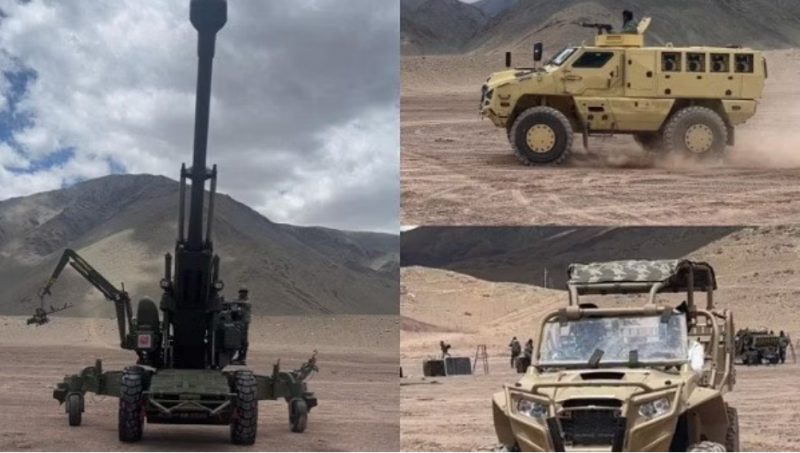
Leh: The Indian Army is continually acquiring newer weapons and capabilities in the Eastern Ladakh sector to handle emergency situations in addition to conducting conventional operations, as the military standoff between India and China has entered its fourth year.
Team ANI travelled to the Nyoma military base, which is at an altitude of about 14,500 feet, where it saw the newer weapon systems and equipment the Indian Army had introduced to bolster its presence and counter the enemy. In recent years, the Indian-made Dhanush howitzer, which was improved upon using the Bofors howitzers' Transfer of Technology, has been introduced to the Army.
The Dhanush howitzer, which was introduced in the Eastern Ladakh sector last year, can strike targets up to 48 kilometres away, according to Captain V Mishra of the Regiment of Artillery.
The former Ordnance Factory Board's 114 guns that it developed and produced will also be joining the Indian Army.
The M4 Quick Reaction Force Vehicle is another Made in India platform that is proving to be very useful for moving troops at very high speeds to the forward locations. It can transport 10 combat-ready armed troops to the forward locations along the Line of Actual Control and can move at speeds of up to 80 kilometres per hour even in the difficult terrain of the Ladakh sector, according to Army officers stationed in the area.
When the enemy troops were using their swiftly moving vehicles to quickly reach the forward locations during face-offs in the early stages of the military standoff, the need for such light armor-protected vehicles became apparent.
Also Read: Shooting inside Lebanon mosque leaves at least one person dead and five others injured
The M4 Quick Reaction Force Vehicles were first introduced to the force last year, and the Army intends to introduce more of these vehicles in the Eastern Ladakh sector's forward areas.
The Army has also introduced a sizable number of All-Terrain Vehicles using the emergency financial authority granted by the government to purchase equipment to aid in carrying out operations after the 2020 standoff.
These vehicles, which can transport four to six soldiers at a time, are used to transport supplies and equipment to forward posts so that the troops there have what they need to survive.
It can also be used to transport troops to areas where they must be deployed more quickly, along with their equipment, to deal with emergency situations.
The vehicles have demonstrated their ability to function even in extremely high altitude regions, including areas where forces have been deployed for the first time since the 2020 standoff.
The new Tata Rajak system, which can observe or detect humans from more than 15 km away and vehicles from more than 50 km away, has been introduced to the force, strengthening the surveillance equipment in the Army inventory.
Also Read: Iran publicly hangs two people over the shooting at the Shiraz shrine
These vehicles, which can transport four to six soldiers at a time, are used to transport supplies and equipment to forward posts so that the troops there have what they need to survive.
It can also be used to transport troops to areas where they must be deployed more quickly, along with their equipment, to deal with emergency situations.
The vehicles have demonstrated their ability to function even in extremely high altitude regions, including areas where forces have been deployed for the first time since the 2020 standoff.
With the introduction of the new Tata Rajak system, which has a range of more than 15 kilometres and a detection range of more than 25 kilometres, the Army's inventory of surveillance equipment has also been strengthened.
The updated gear is assisting the military in tracking enemy movement across the LAC.
As they have been successfully tested over the past few years, the Army also intends to introduce the Made in India K-9 Vajra self-propelled artillery guns in the eastern Ladakh sector.
The L&T group's Hazara plant is expected to deliver more than 100 of these guns to the Army.
The Indian Army has provided the Spike anti-tank guided missiles in the eastern Ladakh sector to arm troops with the tools they need to take on enemy tanks and armoured fighting vehicles.
Following the direct purchases made using emergency powers, more of these third-generation missiles from the Make in India route are anticipated soon.